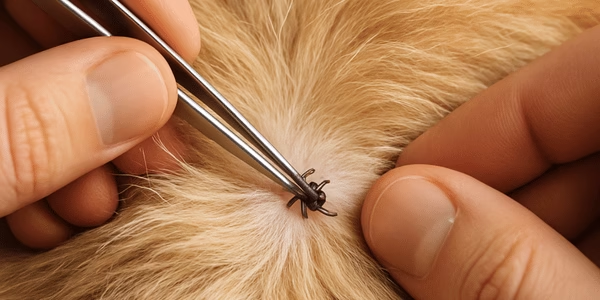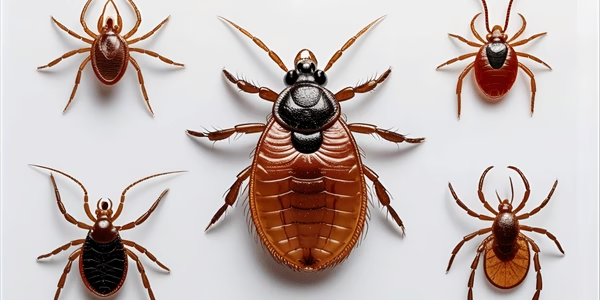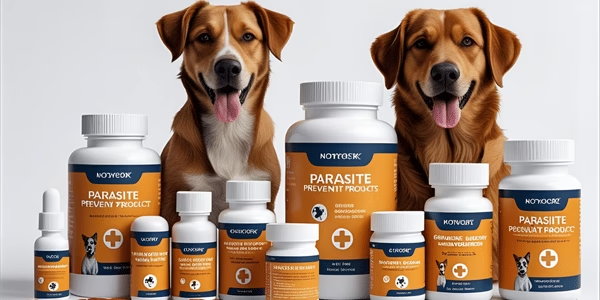This post contains affiliate links and You Site Name is a member of the Amazon Services LLC Associates Program. Which means we may receive a commission from purchases made through links at no extra cost to you. Learn more on our privacy policy page.
⏱️ TL;DR (Quick Start):
- Prevention costs $8–$40/month; treatment costs $200–$3,000+. Do the math.
- Use year-round prevention (parasites don’t follow seasons).
- All-in-one monthly products like Simparica Trio are the easiest option.
- Jump to Cost Calculator or Product Recommendations.
Here’s the thing about dog parasites: they’re basically the uninvited guests at your pup’s health party. And once they show up? They’re incredibly hard to kick out.
Most dog owners think about parasite prevention like they think about getting their car insured—something they know they should do but hope they’ll never actually need. Sounds smart in theory, right?
Except it’s not.
Here’s what actually separates the dog parents with healthy, happy pets from the ones dealing with $3,000 vet bills: they treat parasite prevention like the serious business it actually is.
This guide isn’t going to sugarcoat anything. We’re diving deep into the parasite world, and yeah, some of it’s going to make your skin crawl. But stick with me here, because by the end of this, you’ll have a bulletproof plan to keep your furry friend healthy, and your wallet slightly less devastated.
What We’re Really Fighting Against 🎯
Let’s be real: parasites don’t care if your dog is a pampered Poodle or a rugged rescue mix. They’re equal-opportunity troublemakers, and they come in two flavors.
External Parasites: The Visible Villains 🦟
Fleas are like those annoying relatives who overstay their welcome. A single flea can lay up to 50 eggs per day. Those eggs? They don’t just hang out on your dog. They fall off everywhere,your carpet, your couch, your bed, probably your pillow at 3 AM.
Ticks are the serial killers of the parasite world. They latch on, feed slowly, and can transmit nasty diseases like Lyme disease and anaplasmosis. We’re talking joint pain, fever, lethargy, and neurological problems.
Mites come in different flavors, and none of them are good:
- Ear mites turn your dog’s ears into itchy, waxy nightmares
- Demodex mites cause patchy hair loss and crusty skin
- Sarcoptic mites create that intense itching nightmare known as scabies
Internal Parasites: The Hidden Destroyers 🪱
Roundworms are the most common internal parasites, and here’s the kicker, they can be transmitted to humans, especially kids. Your dog gets a pot-bellied appearance, vomiting, diarrhea, and stunted growth.
Hookworms are small but seriously nasty. They feed on blood and can cause severe anemia, weakness, dark stools, and, in severe cases, especially puppies, death.
Tapeworms are like unwanted roommates in your dog’s intestines. They’re rarely life-threatening, but they’re definitely gross. And they’re usually transmitted through infected fleas.
Heartworms? This is the big one. The parasite that keeps vets up at night. Mosquitoes spread them, and they cause heart failure, lung disease, kidney damage, and death if left untreated.
The Truth About Parasite Prevention 💊
Here’s what the pet industry doesn’t want you to know: most parasite problems are completely preventable.
The catch? You actually have to commit to prevention instead of just hoping nothing goes wrong.
Why Year-Round Prevention is Non-Negotiable
The Seasonal Myth 🌦️
Many dog owners think parasite prevention is seasonal. Wrong. Parasites are like that friend who overstays their welcome, they don’t follow the calendar. Even in winter, your heated home provides the perfect environment for flea eggs to hatch and party.
The Indoor Dog Fallacy 🏠
“My dog stays inside, so they don’t need prevention.” That’s not the get-out-of-jail-free card you think it is. Parasites can:
- Hitch rides on your clothes
- Come in through open doors
- Get tracked in on your shoes
- Enter through other pets in the house
The Real Cost of Skipping Prevention
Let me break down what “saving money” by skipping prevention actually costs:
| Problem | Prevention Cost (Annual) | Treatment Cost |
|---|---|---|
| Heartworm | $50–$120 | $1,000–$3,000 |
| Flea Infestation | $100–$200 | $200–$500 |
| Tick-borne Disease | $50–$150 | $500–$2,000 |
| Intestinal Worms | $60–$100 | $100–$300 |
The math is simple: prevention is always, always cheaper than treatment.
Building Your Dog’s Defense System 🛡️
Creating an effective parasite prevention plan isn’t rocket science, but it does require actual strategy. Here’s how to build something that actually works:
Age-Based Prevention Strategies
Puppies (0–6 months) 🐶
Puppies are basically parasite magnets. Their immune systems are still developing, and they’re often exposed to parasites through their mother’s milk. Here’s what they need:
- Deworming: Every 2 weeks until 12 weeks old, then monthly until 6 months
- Flea prevention: Start as early as 8 weeks (depends on the product)
- Heartworm prevention: Begin by 6–8 weeks old
Adult Dogs (6+ months) 🐕
Once your dog hits adulthood, you can shift to a maintenance schedule:
- Intestinal worms: Every 3 months
- Heartworm: Monthly or annual injection
- Fleas and ticks: Monthly or quarterly products
Parasite Comparison Chart: What You’re Actually Fighting
| Parasite | Symptoms | Treatment | Prevention Cost/Month |
|---|---|---|---|
| Heartworm | Cough, fatigue, difficulty breathing | $1,000+ treatment | $10–$20 |
| Fleas | Scratching, skin irritation, hair loss | Topical/oral medication | $15–$30 |
| Ticks | Lyme disease, fever, joint pain | Removal + antibiotics | $15–$30 |
| Intestinal Worms | Diarrhea, weight loss, pot-bellied appearance | Dewormer | $5–$15 |
Year-Round Prevention Calendar 📅
January–March (Early Spring)
- ✓ Continue heartworm prevention
- ✓ Start flea/tick prevention if paused
- ✓ Schedule spring vet checkup
- ✓ Increase yard maintenance (reduce tick habitat)
April–June (Late Spring/Early Summer)
- ✓ Administer monthly flea/tick prevention
- ✓ Give intestinal worm treatment if needed
- ✓ Check monthly for external parasites during grooming
- ✓ Fecal test if recommended by vet (annual or biannual)
July–September (Summer/Early Fall)
- ✓ Continue monthly heartworm prevention
- ✓ Monthly flea/tick treatment (peak season)
- ✓ Increase tick checks after outdoor activities
- ✓ Monitor for signs of parasite-related illness
October–December (Fall/Winter)
- ✓ Maintain heartworm prevention year-round
- ✓ Adjust flea/tick frequency if in cooler climate (but don’t skip)
- ✓ Schedule annual vet exam and testing
- ✓ Discuss any changes or new concerns with vet
Note: Testing frequency: Annual heartworm test before starting prevention; fecal tests every 6–12 months (more often for puppies, less often for healthy adults).
Recommended Parasite Prevention Products (Amazon)
All-in-One Monthly Treatments 💊
- Simparica Trio Chewable – Fleas, ticks, heartworm, roundworms, hookworms
- Nexgard Spectra Chewable – Fleas, ticks, heartworm, intestinal worms
- Credelio Plus Chewable – Fleas, ticks, heartworm, intestinal worms
Extended-Duration Options ⏰
- ProHeart 6 Injection – 6-month heartworm protection (vet-administered)
- Bravecto Chewable – 3-month flea and tick protection
- Seresto Collar – 8-month flea and tick protection
Water Additives & Supplements
- TropiClean Fresh Breath Water Additive – Helps reduce parasites in drinking water
- Diatomaceous Earth (Food Grade) – Natural supplemental support
Note: Product availability and pricing change regularly. Check current prices and verify they’re in stock before purchasing.
Parasite Prevention Cost Calculator 💰
Budget Option (Basic Protection)
Monthly Cost: $8–$15
Annual Cost: $96–$180
What’s included:
- Heartworm prevention (generic monthly tablet)
- Flea control (generic topical treatment)
- Quarterly intestinal deworming
Best for: Single dogs, lower-risk areas, budget-conscious owners
Mid-Range Option (Comprehensive Protection)
Monthly Cost: $15–$25
Annual Cost: $180–$300
What’s included:
- All-in-one monthly product (heartworm + fleas + ticks)
- Quarterly broad-spectrum worm treatment
- Annual fecal testing
Best for: Families with 1–2 dogs, moderate-risk areas
Premium Option (Maximum Protection)
Monthly Cost: $25–$40
Annual Cost: $300–$480
What’s included:
- Top-tier all-in-one monthly product
- Extended-duration options (less frequent dosing)
- Regular health monitoring and testing
- Professional behavioral support if needed
Best for: Multi-dog households, high-risk areas, senior dogs
RELATED: Senior Pet Care: Essential Tips for Your Aging Furry Friend
Long-term Cost Comparison (5-Year Investment)
| Prevention Level | 5-Year Cost | Expected Treatment Costs Avoided |
|---|---|---|
| Basic | $480–$900 | $1,000+ |
| Comprehensive | $900–$1,500 | $2,000+ |
| Premium | $1,500–$2,400 | $3,000+ |
Bottom line? You’re looking at spending between $500–$2,400 over five years on prevention, versus potentially $1,000–$10,000+ on emergency treatment. Do the math.
Missed Doses & Product Refusal: What to Do 🤔
If You Miss a Monthly Dose
1–3 days late? Give it as soon as you remember. No problem.
4–7 days late? Give it immediately, then resume your normal schedule. Keep a close eye on your dog for any signs of parasites (scratching, lethargy, etc.) during this window.
More than a week late? Contact your vet. Depending on the product and your dog’s risk level, they may recommend an immediate dose or suggest a different approach.
Pro tip: Set phone reminders or use subscription services (like Amazon Subscribe & Save) to prevent missed doses.
If Your Dog Won’t Swallow the Chewable
- Hide in treats: Peanut butter, cream cheese, or pill pockets often work.
- Ask your vet for liquid/topical alternatives: Not all dogs respond to chewables. Topical treatments or injections may be better.
- Crush and mix (if approved): Some products can be crushed. Ask your vet first, not all can.
- Try a different brand: Some dogs prefer the taste of one product over another (yes, really).
RELATED: Pet Vaccination Guide: Keep Your Pet Healthy & Protected
Common Side Effects: What’s Normal vs. Concerning 🚨
Usually Harmless (Monitor at Home)
- Mild lethargy or sleepiness for 24 hours
- Reduced appetite for a meal or two
- Mild vomiting or loose stool (within 24 hours)
- Slight itching at topical application site (brief)
Call Your Vet If You See These
- Persistent vomiting or diarrhea (lasting 24+ hours)
- Lethargy lasting more than a day
- Loss of appetite for more than one meal
- Excessive drooling or difficulty swallowing
- Trembling, seizures, or unusual behavior
- Skin irritation, hives, or swelling at application site
Note: If your dog experiences any reaction, contact your vet. They can recommend an alternative product or adjust dosing.
The Heartworm Prevention Deep Dive 🩺
Let’s get serious about heartworm prevention because this is literally life or death.
Why Heartworm Prevention is Non-Negotiable ⚠️
- Heartworm disease is found in all 50 U.S. states
- A single mosquito bite can transmit the disease
- Treatment is expensive ($1,000–$3,000+), risky, and sometimes unsuccessful
- Prevention is 100% effective when used correctly
Prevention Method Breakdown
| Method | Frequency | Pros | Cons |
|---|---|---|---|
| Monthly Pills | Monthly | Affordable, easy | Easy to forget |
| ProHeart Injection | 6–12 months | No missed doses | More expensive upfront |
| Topical | Monthly | Combines flea/tick prevention | Can be messy, skin irritation possible |
Geographic Specificity: Regional Parasite Prevention 🌍
Different regions come with unique parasite challenges. Knowing your local landscape is crucial.
Hot, Humid Climates 🌡️
Southern United States, Gulf Coast, Southeast
Primary threats: Year-round flea activity, heavy tick populations, high heartworm prevalence
What to do:
- Mandatory year-round heartworm prevention (no gaps)
- Aggressive monthly flea control
- Tick prevention during peak seasons (spring through fall)
- Environmental control (yard treatments, regular grooming)
Cold, Dry Climates ❄️
Northern Plains, Mountain regions, Northern states
Primary threats: Seasonal parasite activity, raccoon roundworm, specific tick species
What to do:
- Seasonal intensification of flea/tick prevention (spring–fall)
- Consistent heartworm prevention (mosquitoes active above 57°F)
- Winter maintenance with reduced-frequency treatments
- Focus on intestinal parasites during hunting season
Temperate Coastal Areas 🌊
Pacific Northwest, Northeast Coast, Great Lakes region
Primary threats: Moderate year-round activity, specific tick-borne diseases
What to do:
- Consistent year-round prevention with seasonal adjustments
- Extra focus on Lyme disease in endemic areas
- Moisture-related parasite control (increased flea activity)
- Regular tick checks after outdoor activities
What Actually Works: Evidence-Based Solutions
Environmental Management
Create Safe Spaces:
- Vacuum regularly (removes flea eggs and larvae)
- Wash pet bedding weekly in hot water
- Maintain low humidity (inhibits flea development)
- Regular grooming (catch parasites early)
Reduce Stressors:
- Keep yard maintained (reduces tick habitat)
- Use diatomaceous earth (natural flea control)
- Control rodent populations (reduces worms)
Product Categories That Actually Work
All-in-One Monthly Treatments 💊
These are the Swiss Army knives of parasite prevention:
- Simparica Trio: Fleas, ticks, heartworm, roundworms, hookworms
- Nexgard Spectra: Fleas, ticks, heartworm, intestinal worms
- Credelio Plus: Fleas, ticks, heartworm, intestinal worms
Extended-Duration Options ⏰
For owners who prefer less frequent dosing:
- ProHeart 6: 6-month heartworm injection
- ProHeart 12: Annual heartworm injection
- Bravecto: 3-month flea and tick chewable
- Seresto Collar: 8-month flea and tick protection
Common Prevention Mistakes (And How to Avoid Them) ❌
The Seasonal Trap
- The mistake: Only providing protection during warm months
- The reality: Many parasites are year-round threats
- The fix: Maintain consistent protection regardless of season
The Indoor Dog Fallacy
- The mistake: Thinking indoor dogs don’t need protection
- The reality: Parasites can enter homes in multiple ways
- The fix: Protect all dogs, regardless of lifestyle
The Cheap Product Gamble
- The mistake: Choosing the cheapest prevention option
- The reality: Ineffective products waste money and leave dogs vulnerable
- The fix: Invest in veterinary-recommended products
The Inconsistent Dosing Problem
- The mistake: Missing doses or irregular administration
- The reality: Gaps in protection leave dogs vulnerable
- The fix: Set reminders, use auto-delivery, or choose longer-duration products
Your Action Plan: What to Do Right Now 🚀
This Week:
- ☐ Evaluate your current prevention program
- ☐ Identify gaps in protection
- ☐ Schedule a veterinary consultation
- ☐ Check your area’s specific parasite threats
Next Month:
- ☐ Start your chosen prevention protocol
- ☐ Set up reminder systems (phone alerts, auto-delivery)
- ☐ Establish monitoring routines
- ☐ Create your prevention calendar (print or bookmark this page)
Ongoing:
- ☐ Watch for side effects or issues
- ☐ Track effectiveness
- ☐ Adjust based on seasonal or lifestyle changes
- ☐ Maintain consistent administration
Final Thoughts: Your Dog’s Health is Worth It 💝
Parasite prevention isn’t glamorous. It won’t get you Instagram likes or spark interesting conversations at the dog park.
But here’s what it actually is: one of the most important investments you’ll make in your dog’s health and happiness.
Every month you maintain consistent parasite prevention, you’re giving your dog the gift of comfort, health, and potentially years of additional life. That’s worth more than any fancy toy or premium treat.
The parasites are out there, and they’re not going away. But with the right prevention strategy, they don’t have to be your problem.
Your dog is counting on you to make the smart choice. The evidence is clear, the products are available, and the benefits are undeniable.
So what are you waiting for? 🐕❤️
FAQ Section
Can I use cheaper generic products instead of brand-name prevention?
Most of the time, yes. Many effective parasite prevention products are available in generic formulations with identical active ingredients. Ask your vet about generic options, you could save 25–50% on the same protection.
What if my dog has a reaction to flea prevention?
Contact your vet immediately. Some dogs are sensitive to certain ingredients. Your vet can recommend an alternative product or switch to a different class of parasite preventative.
Is year-round prevention really necessary in cold climates?
For heartworm? Yes, absolutely. Mosquitoes can be active above 57°F, even in northern states. For fleas and ticks, you can reduce frequency in winter, but don’t skip it entirely, outdoor temps fluctuate, and homes are warm.
What’s the difference between topical and oral parasite prevention?
Topical treatments are applied to the skin (usually between shoulder blades) and work locally and systemically. Oral medications work from the inside out. Both are effective; it’s about which works best for your dog’s lifestyle and tolerance.
Should I give my dog parasite prevention year-round or just seasonally?
Year-round. Parasites don’t follow the calendar, and your heated home is a perfect environment for flea reproduction in winter.
What if my dog vomits after taking the medication?
If it happens immediately (within 15 minutes), there’s a chance the dose didn’t absorb. Contact your vet about whether to redose. If it happens later (several hours), the dose likely absorbed. Monitor for any signs of parasites and contact your vet if you’re concerned.










